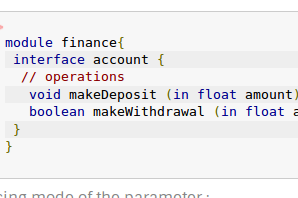

If you do not specify these preprocessor definitions at compile time, these functions are not automatically defined. def $ ( PROXYSTUBOBJS ) $ ( ORIXYSTUBLIBS ) regsvr32 / s proxy. c CL / c / DWIN32 / DREGISTER_PROXY_DLL example_p. c CL / c / DWIN32 / DREGISTER_PROXY_DLL dlldata. The default name is that of the IDL file, with a. Specifies the name of the type library file.
Idl definition plus#
The default name is that of the IDL file plus "_p.c". Specifies the name of the interface proxy file for a COM interface. The default is that MIDL writes the files to the current directory. The output directory can be specified with a drive letter, an absolute pathname, or both. Specifies the directory to which the MIDL compiler writes output files. The /Oic and /Oicf switches provide additional performance enhancements. This switch turns off this optimizing behavior.ĭirects MIDL to use a fully interpreted marshaling method.
Idl definition full#
Provides full DBCS support so that you can use international characters in your input files, filenames, and directory paths.īy default, to reduce code size, MIDL eliminates duplicate descriptors. Specifies an interface identifier filename that overrides the default interface identifier filename for a COM interface. The default name is that of the IDL file with an. Specifies the name of the interface header file. The default filename is Dlldata.c.ĭirects MIDL to generate stubs or a type library for a target environment. Specifies a filename for the generated DLL data file for a proxy DLL.

This switch also enables the use of different interface names in the IDL and ACF files. You can use the following command-line options to override some of the default behavior of the MIDL compiler and to choose optimizations appropriate for your application. You can choose to include the type library file as a resource in your EXE or DLL, or you can ship it as a separate file. You use the interface header file (Example2.h) and the interface ID (Example2_i.c) file when creating the executable file for a client application that uses the interface. c files to create a proxy DLL that can support the interface when used both by client applications and by object servers. The interface ID file, which defines the GUID for every interface specified in the IDL file.Ī compound document file that contains information about types and objects.Ĭontains the data you need to create a proxy/stub DLL. The proxy/stub file, which includes the surrogate entry points both for clients and for servers. The header file, containing type definitions and function declarations for all of the interfaces defined in the IDL file as well as forward declarations for routines that the stubs call. Given an IDL file, such as Example2.idl, that defines one or more COM interfaces and a type library, the MIDL compiler (Midl.exe) generates the files described in the following table as the default output. The retval attribute in MethodD designates an output parameter that contains the return value of the function. The propget attribute indicates that the method retrieves information from a property of the same name as the method.

The propput attribute on MethodD indicates that the method performs a set action on a property of the same name. IFace4 is described within the library statement. The default attribute designates IFace1 as the default interface. The coclass statement defines an entirely new component class, BkfstComponent, that includes two previously defined interfaces, IFace1 and IFace2. IFace3 is included merely by referencing it within the library statement. This type library definition demonstrates three different ways to include interfaces in the type library. All type library definitions should bring in the base type library defined in Stdole32.tlb. Within the type library definition, the importlib directive brings in a compiled type library. The library statement defines the ExampleLib type library, which has its own uuid, helpstring, and version attributes. IFace3 imports Oaidl.idl to get the definition of IDispatch. Because it is derived from IDispatch, a dual interface supports Automation, which is what the oleautomation attribute specifies.

The dual attribute on IFace3 creates an interface that is both a dispatch interface and a COM interface. These help strings are readable with an object browser such as the one provided with Microsoft Visual Basic. The helpstring attribute is optional you use it to briefly describe the object or to provide a status line. // Example.idl // import "mydefs.h", "unknwn.idl" interface IFace1 : IUnknown //end library def


 0 kommentar(er)
0 kommentar(er)
